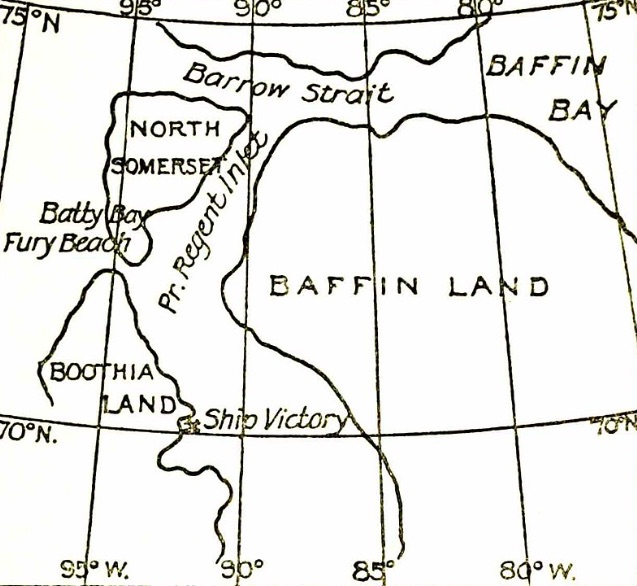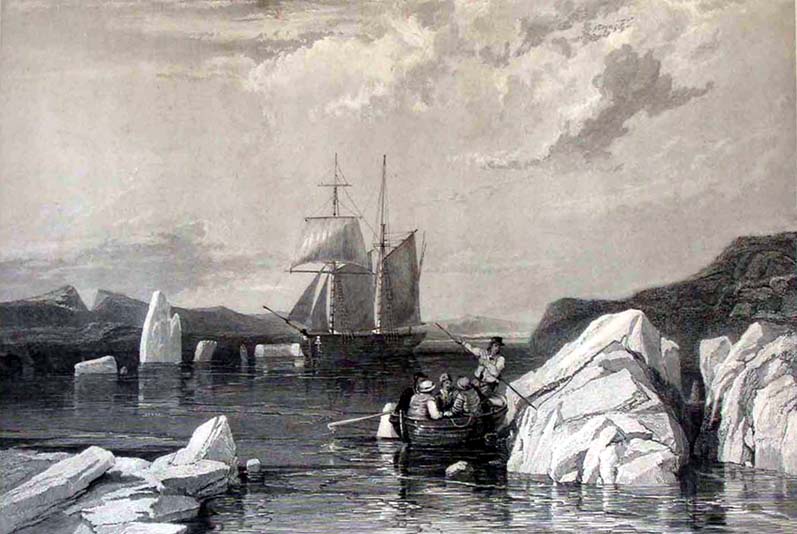
Wooden paddle steamer Victory, built Humble & Hurry, Liverpool, 1826,
69 tons burden, 92.5 x 16.1 x 7.7 ft, engines of 30 hp by Gladstone &
Foster, Liverpool.
Registered at Liverpool 1826 in name of builders. Used for
excursions and towing.
1826-7: Reported on a short-lived Douglas - Liverpool service run by
Captain Cosnahan (a manxman living in Liverpool) over the winter of
1826/7 [as also was Hero somewhat later]
1829 on, bought by explorer Captain John Ross, and taken to London to be fitted out for an
Arctic expedition, with new smaller high pressure engines, made by John
Braithwaite & Ericsson (best known for steam fire-engines), and no funnel.
Trapped in
ice, while searching for the North West passage, and subsequently
abandoned in May 1832. Of 23 aboard, 3 died and the remainder reached
safety. Location Victoria Harbour, east coast of Boothia peninsula,
named after sponsor Felix Booth (of Booth's gin), also near NE corner of
Thom Bay. Position (as recorded by Ross - longitude approximate)
70°11.03N, 91°30.0W. Some iron and wood from the ship was later
salvaged by Inuits (the Netsiligmiut). Also later reports of wreckage
somewhat further offshore than Victoria Harbour.
Letter of complaint to [Liverpool Mercury - Friday 04 August
1826]:
The Victory and Abbey packets started with a great number
of people on board each, to make the usual uninteresting trip round the
Floating Light; when in the centre of the river, nearly opposite the
Magazines, the Victory, which was the more powerful vessel, in coming up
to the other, which had started first, brushed alongside, without
creating much sensation or alarm. After passing the Rock Perch, she ran
aground, which probably caused a quarter of an hour's delay, and enabled
the Abbey first to reach the Floating Light. However, about a mile on
this side of the Light, the Victory again overtook her, and again ran
against her without doing any injury; but not being satisfied, she
sheered off again, only to come against her with greater force, when she
actually carried away her waist, just abaft the paddle-box, and caused a
fearful sensation in the minds of the passengers, particularly the
females, of which there were a great number.
[from Gore's Liverpool General Advertiser - Thursday 11 June 1829]
By a letter from the Isle of Man, dated on Thursday last, we learn,
that the Victory steamer. Captain Ross, from London the Clyde, where
she is to join the store-ships for the northern expedition, had put into Douglas
that morning, having carried away the key of the main shaft of her
engine, off Dover, and come round without steam.
[from Westmorland Gazette - Saturday 20 June 1829]:
The Polar Expedition. Douglas, Isle Man, June 9. On Thursday morning, Capt. Ross in
his steam-vessel the Victory, with which he is about once more to
attempt the discovery of the north-west passage, arrived in our bay,
and remained till Saturday morning, when she sailed for Stranraer.
During her stay several persons went on board of this nouvelle and
extraordinary model of naval architecture. It is said, the expedition is
equipped entirely at the captain's expense. The steam power employed in
the Victory is on a wholly-new principle, being so contrived as to
combine every advantage of steam power with perfect capability as a
sailing vessel. The boilers used occupy so small a space, that they are
fixed between the engines. The consumption of fuel is one-half, and
the weight of the engines only one-fourth of those generally in use.
Another advantage gained is that the chimney may be dispensed with,
which leaves the deck, masts, and rigging wholly
unincumbered.
First engine on sale [from Chester Chronicle - Friday 17 April 1829]:
TO BE SOLD BY AUCTION, Without
reserve, on Monday the 20th inst. at twelve o'clock, at Jones, Mann,
and Foster's office, Dales-treet, Liverpool, AN excellent STEAM ENGINE,
thirty-two horses power, on the wheel principle, Cylinder 32.25 inches
diameter, 3 feet stroke. The Engine was made by Messrs. Gladstone and
Foster, for the Steam Packet Victory, has only been two years in use,
and is in most complete order. It is equally applicable to land
purposes. Apply to Mr. Jos. C. Nicholson, merchant; or Jones, Mann, &
Foster, brokers, Liverpool.
Sketch map of area where Victory was abandoned:

Summary of expedition [from 1835
account]
Explorer John Ross first
voyaged to find the North-West Passage, the seaway through the Arctic,
linking the Atlantic and Pacific Oceans in 1818. He had wrongly
claimed that Lancaster Sound was enclosed by mountains and was keen to
restore his reputation. He thought that a smaller, shallower ship,
with an auxiliary steam engine, would have more success than the
larger vessels that had been sent to the Arctic. The British
Admiralty had no interest in backing the voyage after Ross's previous
failure, so Felix Booth, a gin magnate, supplied the funding. Ross set
sail with his nephew, James Clark Ross, in May 1829 on board the
reinforced steamer Victory. The voyage would turn into a four-year
ordeal.
They became stuck in the ice and had to stay over winter. They were able to establish friendly relations with the Inuit - to their mutual benefit.
Ross laments that the engine was not merely useless: it was a serious
encumbrance; since it occupied, with its fuel, two-thirds of their tonnage. The
engine was removed from the ship entirely.
The next
summer, they were only able to sail a short distance before the Victory
was trapped again: 
When it became clear that the Victory would remain stuck in the ice for the winter of 1831-32, Ross decided to abandon ship the following spring. The crew went north on foot to Fury Beach, a journey of 300 miles. Here they set about repairing the Fury's boats, which had been abandoned by William Edward Parry in 1825. The aim was to row to Baffin Bay and meet the whaling fleets there the following year.
After a year's delay, the party were able to reach open water and were succesfully picked up by whaling ship Isabella, in August 1833, after spending 4 winters in the Arctic. Only 3 of the crew had died during this period.